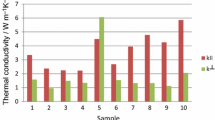Abstract
The Tuoku region in northern Tarim Basin of China is a key area for studying oil/gas reservoir rocks. The magnetic and mineralogical parameters of well cuttings from two wells, well S7, situated on oil/gas field, and well S6, at an oil/water interface, were measured. The two wells are located in the same structure with similar strata and types of lithology, but well S6 is a showing well of oil and gas 5 km northwest of well S7. The purpose of this paper is to evaluate the possibility and distribution of secondary magnetic alteration that may have occurred due to hydrocarbon migration above an oil/gas accumulation. It is concluded that the magnetism of well cuttings from major strata in well S7, including source rocks, oil reservoir rocks and cap rocks, and in Quaternary (Q) soil is higher than that from well S6. The Cambrian oil-bearing strata and cap rocks have even higher magnetism in well S7. The shape and parameters of magnetic hysteresis loops indicate that soft (H c<20 mT,H s<0.3 T) ferrimagnetic components dominate the magnetic carriers within the strongly magnetic strata of well S7, whereas a mixed paramagnetic and ferrimagnetic distribution occurs in well S6 (for example, low coecivityH c and nonsaturating magnetized character). Analysis of heavy minerals shows that the contents of iron oxide (magnetite, maghemite and hematite) in well S7 are often higher than those in well S6. The magnetite content in samples of cuttings from Cambrian rocks can reach 9.7% in oil-bearing strata in well S7, and in strata Ekm and N1j are 1.215% and1.498%, respectively. Typical spherical magnetite grains are found within the main source rocks and the soils in well S7. By analysis of surface microtexture and of trace element contents, we infer that the spherical magnetite is composed of aggregates of ultrafine particles that are probably authigenic magnetite formed in a hydrocarbon halo background.
Similar content being viewed by others
References
Donovan, T. J., Forgey, F. L., Roberts, A. A., Aeromagnetic detection of diagenetic magnetite over oil fields,AAPG, 1997, 63:245.
Kilgore, B., Elmore, R. D., A study of the relationship between hydrocarbon migration and the precipitation of authigenic magnetic minerals in the Triassic Chugwater Formation, southern Mountana,Geological Society of America Bulletin, 1989, 101:1280.
Benthien, R. H., Elmore, R. D., Origin of magnetization in the Phosphoria Formation at Sheep Mountain, Wyoming:A possible relationship with hydrocarbon,Geophysical Research Letters, 1987, 14:323.
Elmore, R. D., Engel, M. H., Crawford, L. et al., Evidence for a relationship between hydrocarbon and authigenic magnetite,Nature, 1987, 325:428.
Elmore, R. D., Crawford, L., Remanence in authigenic magnetite:Testing the hydrocarbon magnetite hypothesis,Journal of Geophysical Research, 1990, 95(B):4539.
McCabe, C., Sassen, R., Saffer, B., Occurrence of secondary magnetite within biodegraded oil,Geology, 1987, 15:7.
Sassen, R., McCabe, C., Kyle, J. R., Deposition of magnetic pyrrhotite during alteration of crude oil and reduction of sulfate,Organic Geochemistry, 1989, 14:381.
Gao Guoqiang, Ye Desheng, Wang Meiling, Study on cap rocks in Northern Tarim, inResearch of Petroleum Geology of northern Tarim Basin in China (ed. Jia Runxu) (in Chinese with English abstract), Vol. 2, Wuhan:China University of Geosciences Press, 1991, 139.
Li Nanho, Li Guorong, Tan Wenbin, Controlling factors of Sinian and Lower Paleozoic carbonate reservoirs in Northeastern Tarim, inResearch of Petroleum Geology of Northern Tarim Basin in China (ed. Jia Runxu) (in Chinese with English abstract), Vol. 1, Wuhan:China University of Geosciences Press, 1991, 237.
Zhang Daquan, Li Ming, Zhang Xianshu, Tectonic divisions and hydrocarbon prospects in north Tarim Basin, inResearch of Petroleum Geology of Northern Tarim Basin in China (ed. Jia Runxu) (in Chinese with English abstract), Vol. 2, Wuhan:China University of Geosciences Press, 1991, 17.
Liu Qingsheng,The Basic Principle and Applications of Micromagnetic Method in Oil & Gas Exploration (in Chinese with English abstract), Wuhan:China University of Geosciences Press, 1996, 1–146.
Liu Qingsheng, Cheng Tongjin, Liu Shugen, Comprehensive evaluation of the mechanism of “Chimney-like Effect” using principle of magnetic, geochemistry and mineralogy,Chinese Science Bulletin, 1997, 42:1569.
Wasilewski, P. J., Magnetic properties of mantle xenoliths and magnetic character of the crust-mantle boundary, inMantle Xenoliths (ed. Nixon, P. H.), New York:John Wiley and Sons, 1984, 557–588.
Bagin, V. T., Malumyan, L. M., The iron-bearing minerals in the oil-impregnate sedimentary rocks of the productive sequence of Azerbayelzhan:Ilzvestiya AN SSSR,Fizika Zemli, 1976, 4:73.
Chen Lihua, Niu Xi, Yu Zhong,Applications of SEM in Geology (in Chinese), Beijing:Science Press, 1986.
Reynolds, R. L., Fishman, N. S., Wangty, R. B. et al., Iron sulfide minerals at Cement oil field, Oklahoma:Implications for magnetic detection of oil fields,Geological Society of America Bulletin, 1990, 102:368.
Liu Qingsheng, Zhang Changda, Qu Zan et al., A study of the relationship between the magnetism of authigenic magnetic minerals and hydrocarbon migration,Earth Science Journal of China University of Geosciences (in Chinese with English abstract), 1991, 16:565.
McCollum, R. A., Paleomagnetic and rock magnetic investigation of the relationship between hydrocarbons and authigenic minerals in the Permian Lyons sandstone, Northern Front Rang and Denver Basin, Colorado,Master Thesis, The University of Oklahoma, Normam, Oklahoma, 1988, 81.
Author information
Authors and Affiliations
Additional information
Project supported by the National Natural Science Foundation of China and the Geological Industry Foundation of China (Grant No. 49374216) and Foundation of the State Key Laboratory of Oil/Gas Reservoir Geology and Exploitation of China (Grant No. 9608).
Rights and permissions
About this article
Cite this article
Liu, Q., Liu, S., Qu, Z. et al. Magnetic and mineralogical characteristics of hydrocarbon microseepage above oil/gas reservoirs of Tuoku region, northern Tarim Basin, China. Sci. China Ser. D-Earth Sci. 41, 121–129 (1998). https://doi.org/10.1007/BF02932430
Received:
Revised:
Issue Date:
DOI: https://doi.org/10.1007/BF02932430




